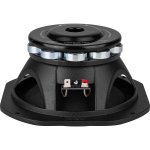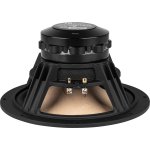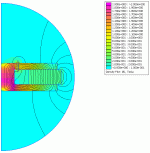While shopping for a massive sized Neo Axial polarity ring magnets for a project, trying to get some outstanding Qes values, I'm finding some 200mm diameter, 12mm thick, with a 52mm inner diameter dimensions...but upon pricing such a large magnet, $200+ for each one!!! I thought I could stack a half dozen, $1200 USD worth of magnetic force! Then I remembered those few particular drivers that "showed off" their trick magnet assemblies...it was the utterly cheap tiny pill sized magnets...those ones that sell for some four dollars a pop...they cutely arranged them in a radial pattern.
The really expensive drivers?, I'm betting they are the ones with the "real thing".
-------------------------------------------------------------------------Rick..........
The really expensive drivers?, I'm betting they are the ones with the "real thing".
-------------------------------------------------------------------------Rick..........
Attachments
Last edited:
Qes may be soft-limited by pole piece saturation. Even cheap speakers work the iron near the knee to reduce variation among magnets.
OK, with unlimited magnet money you can run a longer voice coil, more conductor in the gap. But that also raises mass, which raises Q.
OK, with unlimited magnet money you can run a longer voice coil, more conductor in the gap. But that also raises mass, which raises Q.
Those small disc magnets are very dangerous to handle. They stick together in a fraction of a second with enormous force, not respecting your finger between them. Then it is impossible to separate them.
Hi Rick,
the small magnets are dangerous, but big axial neodym magnets are real beasts and have to be handled with utmost care, precision and respect. Think twice about everything you do with them.
Now, regarding speaker motors, FEMM will reduce your guesswork to a large margin and will show you quite exactly what´s going on in your motor, where advantages and disadvantages are and when your metal parts are saturated. You will most possibly find the reason for using the small pills - price - and you may find out that axial rings do not need to be that large, if you´re not building an enormous woofer. Depending on airgap, core and poleplate geometry and material, there´s a point after which larger magnets are not resulting in more flux anymore, and with some work, you´ll find the optimum "balance" for your design.
All the best
Mattes
the small magnets are dangerous, but big axial neodym magnets are real beasts and have to be handled with utmost care, precision and respect. Think twice about everything you do with them.
Now, regarding speaker motors, FEMM will reduce your guesswork to a large margin and will show you quite exactly what´s going on in your motor, where advantages and disadvantages are and when your metal parts are saturated. You will most possibly find the reason for using the small pills - price - and you may find out that axial rings do not need to be that large, if you´re not building an enormous woofer. Depending on airgap, core and poleplate geometry and material, there´s a point after which larger magnets are not resulting in more flux anymore, and with some work, you´ll find the optimum "balance" for your design.
All the best
Mattes
If it is for experimental work, forget cheesy newfangled "permanent" magnets and build a field coil one instead.
You can dial in as much flux density as you want, way beyond what polepiece and plates can handle.
In the 80´s I built a 30" woofer for Disco use, and only way was to make a field coil.
You can dial in as much flux density as you want, way beyond what polepiece and plates can handle.
In the 80´s I built a 30" woofer for Disco use, and only way was to make a field coil.
Hi,
for sure a fieldcoil motor is a very good alternative as well (I have fieldcoil fullrange drivers and like them a lot), and also here FEMM will help a lot determining what you´re doing.
All the best
Mattes
for sure a fieldcoil motor is a very good alternative as well (I have fieldcoil fullrange drivers and like them a lot), and also here FEMM will help a lot determining what you´re doing.
All the best
Mattes
I am just curious what is the sense of a field coil, when the pole piece is saturated at a certain magnetic field strength, so the flux density in the gap is limited by the iron properties. If you increase the field strength, the flux density does not increase beyond a certain value.
I'll be downloading that FEMM program on the other machine shortly...I have a collection of drawings, trying to get an intuitive grasp on the lines of force...one thing i had noticed was the propensity to model out with conventional shapes...It would seem, given a fixed variable, the size & dimensions of an available magnet, I believe shapes of backing plated & pole pieces would be a great place for some insights & discoveries.
--------------------------------------------------------------------------Rick.......
--------------------------------------------------------------------------Rick.......
Attachments
It may also be fun to model the current sheet of the vc to see how the drive affects the model, through all vc positions.
Adding velocity, well that I think is wishful thinking, but something to ponder. The gap edges are quite important.
Nice work and discussion, thanks.
John
Adding velocity, well that I think is wishful thinking, but something to ponder. The gap edges are quite important.
Nice work and discussion, thanks.
John
Do you run them constant voltage or constant current?Hi,
for sure a fieldcoil motor is a very good alternative as well (I have fieldcoil fullrange drivers and like them a lot), and also here FEMM will help a lot determining what you´re doing.
All the best
Mattes
Jn
Hi JN,
I run my fieldcoils from 20Ah LiIon batteries, so on first hand they´re driven by "constant" voltage. "Constant" insofar as that of course after some time (in reality more than 10 hours) the voltage drops, time for a charge.
As the batteries are rated for for more than 4A continous, I believe that the current should be pretty stable as well, a little bit more than 1A is needed for the speaker.
In listening, compared with decent linear PSUs and medical grade switching supplies, the difference is not night and day, but I prefer the batteries.
I would like to try a current regulated PSU, but have not yet found any feasable solutions.
All the best
Mattes
I run my fieldcoils from 20Ah LiIon batteries, so on first hand they´re driven by "constant" voltage. "Constant" insofar as that of course after some time (in reality more than 10 hours) the voltage drops, time for a charge.
As the batteries are rated for for more than 4A continous, I believe that the current should be pretty stable as well, a little bit more than 1A is needed for the speaker.
In listening, compared with decent linear PSUs and medical grade switching supplies, the difference is not night and day, but I prefer the batteries.
I would like to try a current regulated PSU, but have not yet found any feasable solutions.
All the best
Mattes
- Home
- Member Areas
- The Lounge
- The Neodymium magnet racket


